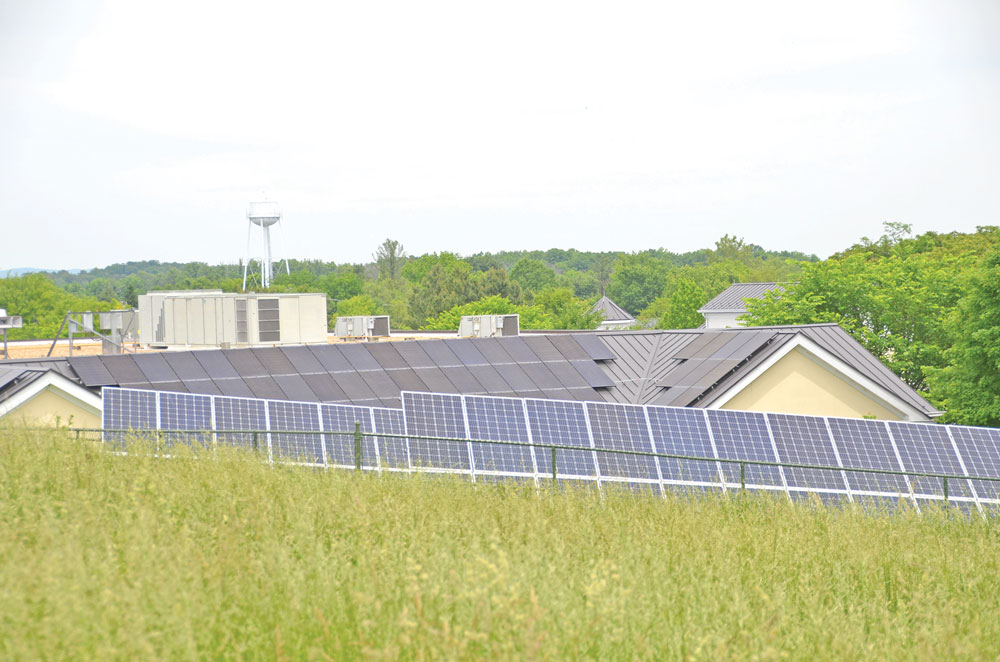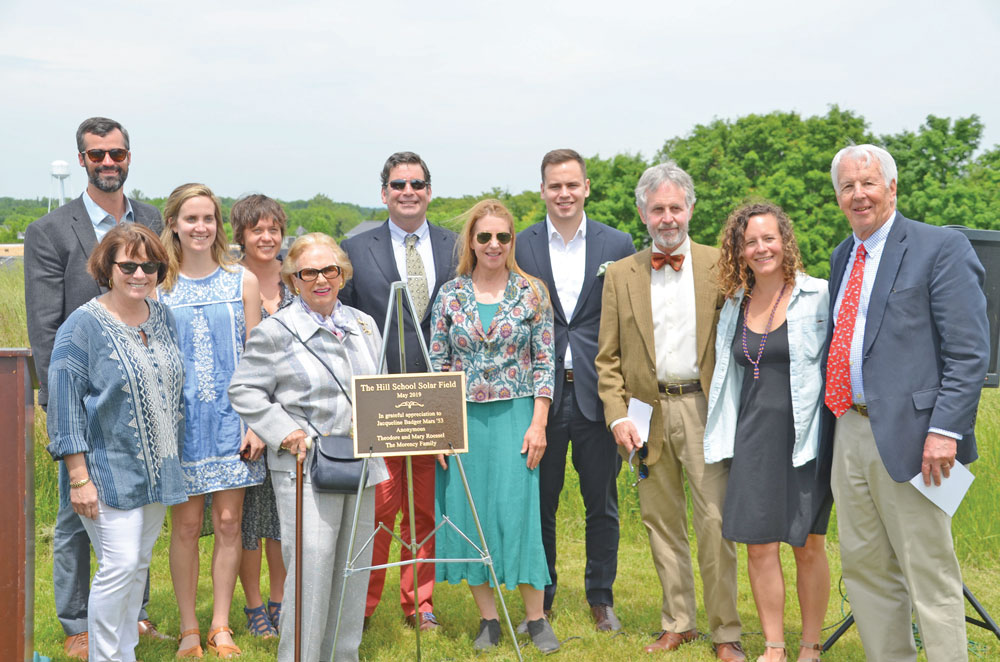Hill School Solar Field Dedicated

Story and Photos by Michelle Baker
The sun came out for the dedication of the newly installed Hill School Solar Field on Wednesday, May 22.
The utilization of the Solar Field in the school’s place-based education curriculum is already being articulated by the 7th and 8th grade science and math programs who have used the field as a catalyst to create a 3D model of the system to analyze the system’s generation and benefits, evaluate solar business models, and expand understanding of renewable energy generally.
Members of the class, staff and donors spoke to the crowd of supporters. “In the early spring, the eighth grade held an environmental seminar that explored about ways to help the environment,” said Cyna Peters. “Our class wrote presentations on power source alternatives and my presentation was on solar power.”

“In science class Cyna and I made a presentation about solar energy, how it is used and how it benefits the environment,” said Aris Roberts. “Some cool facts that I learned were about the history of solar panels: it was founded in 1839, more developed in 1876, and from 1876 to 1953 no new developments were found. In 1954, Bell Labs three scientists created the first solar panel.”
Eighth-grader Anya Turner-Veselka shared more about the electrical source. “Most renewable forms of energy required that the initial collected energy be converted separately into an electrical stream, during which energy is lost. Solar energy is collected in the form of a current, making it capable of gleaning the most possible energy from the source,” said Turner-Veselka
“It has been a fascinating experience to be on a campus with solar panels both because of the environmental benefits, and because they provide a physical example of the application of technology. We thank Sigora and the Hill supporters for giving us this unique opportunity to learn and affect the future of the world we live in for the better,” concluded Turner-Veselka.
Based in Charlottesville, Virginia, Sigora Solar is the largest residential and commercial solar provider in Virginia. The 127.8kW DC field was designed and installed by Sigora Solar and resulted in minimal excavation and impacts to the school’s grounds and embodies the school’s commitment to environmental stewardship and sustainability.
Two seventh graders from Katherine Weeden’s math class also spoke about how much energy solar power provided in each month and how much money was saved. “Aside from building the model, a small group analyzed the data from the solar panels. We looked at how much energy the solar field provided in each month,” said Zoe Korff.

“Pairs of seventh grade math students worked together to build a 1:36 scale model of the solar field,” said Chester Fannon whose work along with other students was on view for visitors. The school is already reaping rewards. For instance last September, Korff shared that the school would have spent approximately $1950 on electricity in the gym but because of the solar field, it only spent $750. To date, the field has produced the equivalent of planting 3,250 trees or saving over 120,000 albs of CO2 emissions.
Hill School, founded in 1926, is a junior kindergarten through 8th grade independent school situated on 137 rolling acres outside of the town of Middleburg, is focused on the maintenance and growth of a community focused on character, community, and confidence with a curriculum that includes place-based education. The school’s current enrollment is 222 students.
The design seamlessly incorporates the solar system into the landscape by situating the solar panels on a south facing sloping meadow and the roof of the school gymnasium. The system leverages the Virginia net metering law, a utility billing mechanism that enables residential and commercial utility customers to receive a one-for-one credit for all energy generated by their solar system up to 100 percent of the previous years’ consumption.
The Hill School Solar Field’s generation will potentially offset 1/3 of electricity use on campus, resulting in utility bill savings, squarely aligning the school’s desire for clean energy with financial savings. The system will also provide greater utility bill certainty and insulation from fossil fuel price volatility to the School. Funding for the Solar Field was provided by generous individuals in the community who shared a vision of responsible resource use and environmental stewardship.
Featured speakers included Redmond Manierre, Michael Morency and Jacqueline Mars. “It really gives me great pride and pleasure to stand here to day at the dedication of Hill School’s Solar Field,” said Mars. “I am a Hill School graduate and I have always considered this area my home and I love it especially when you look around and see what all we have,” said Mars. “And I hope you all do appreciate it.”
“I am particularly proud that Hill School has such a long standing interest in being a responsible institution that is aware of its footprint on the beautiful land that surrounds it. The Solar Field is a physical manifestation of the school’s commitment to Place-Based education, environmental stewardship, and the value of alternative energy sources. We are proud to have it as part of our campus and program,” said Head of School Treavor Lord.
This article first appeared in the June 2019 issue of Middleburg Life.


